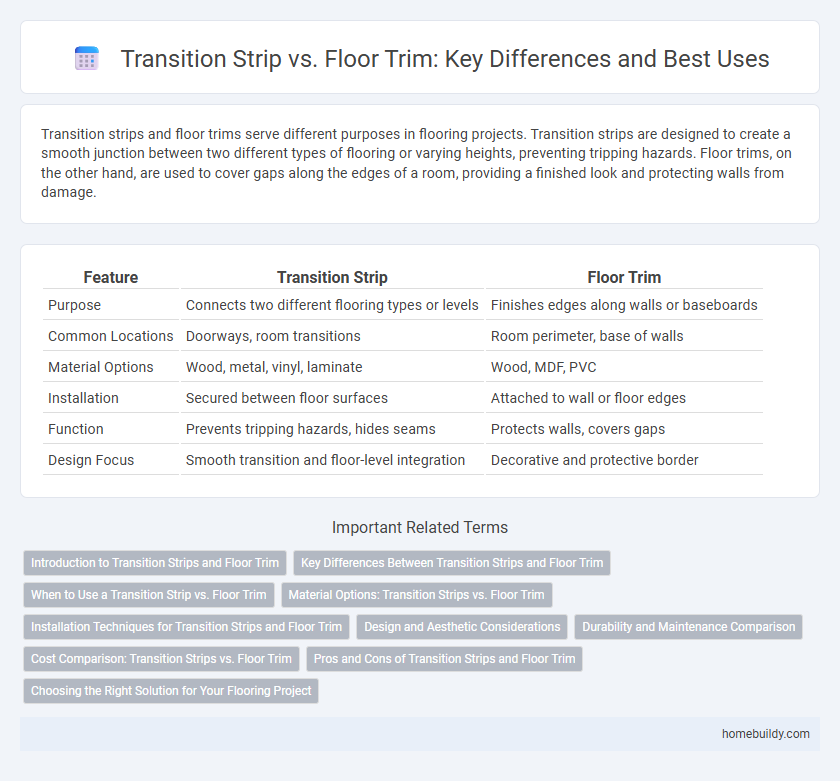Transition strips and floor trims serve different purposes in flooring projects. Transition strips are designed to create a smooth junction between two different types of flooring or varying heights, preventing tripping hazards. Floor trims, on the other hand, are used to cover gaps along the edges of a room, providing a finished look and protecting walls from damage.
Table of Comparison
| Feature | Transition Strip | Floor Trim |
|---|---|---|
| Purpose | Connects two different flooring types or levels | Finishes edges along walls or baseboards |
| Common Locations | Doorways, room transitions | Room perimeter, base of walls |
| Material Options | Wood, metal, vinyl, laminate | Wood, MDF, PVC |
| Installation | Secured between floor surfaces | Attached to wall or floor edges |
| Function | Prevents tripping hazards, hides seams | Protects walls, covers gaps |
| Design Focus | Smooth transition and floor-level integration | Decorative and protective border |
Introduction to Transition Strips and Floor Trim
Transition strips bridge different flooring types, providing a smooth and safe shift between surfaces such as hardwood and tile. Floor trim, including baseboards and shoe molding, primarily enhances room aesthetics by covering gaps between floors and walls. Both elements protect edges but transition strips focus on functionality at floor junctions, while floor trim emphasizes finishing touches along perimeters.
Key Differences Between Transition Strips and Floor Trim
Transition strips bridge the gap between different types of flooring materials, ensuring a smooth and safe surface transition, while floor trim primarily serves to cover the perimeter of a room to hide expansion gaps and provide a finished look. Transition strips vary in materials such as wood, metal, or vinyl, designed specifically to accommodate height differences, unlike floor trim which is generally uniform in shape and used along walls. Key differences include their purpose, installation location, and functional design, with transition strips focusing on flooring junctions and floor trims emphasizing wall-floor boundaries.
When to Use a Transition Strip vs. Floor Trim
Use a transition strip when bridging two different types or heights of flooring, such as hardwood to tile, to ensure a smooth and safe surface change. Floor trim is best suited for finishing edges along walls or baseboards to create a polished look and cover gaps between the floor and wall. Choosing the right option depends on whether the goal is to connect distinct flooring sections or to complete the room's perimeter.
Material Options: Transition Strips vs. Floor Trim
Transition strips commonly come in materials like aluminum, wood, and vinyl, designed to bridge gaps between different flooring types and provide a smooth, level surface. Floor trim typically features options such as hardwood, MDF, and PVC, primarily serving as decorative edging along walls to cover expansion gaps and protect floor edges. Choosing between transition strips and floor trim depends on the specific flooring interface and aesthetic requirements, with material selection directly influencing durability and installation ease.
Installation Techniques for Transition Strips and Floor Trim
Transition strips often require precise measurements and securing with adhesive or screws to bridge floor surfaces seamlessly, while floor trim installation emphasizes nailing or gluing baseboards to walls for a polished edge. Transition strip installation demands alignment between varying floor heights or materials, ensuring a smooth transition without tripping hazards. Proper subfloor preparation and choice of mounting hardware are critical for both applications to achieve durability and aesthetic appeal.
Design and Aesthetic Considerations
Transition strips seamlessly connect different flooring types while maintaining a smooth visual flow, enhancing room continuity and design harmony. Floor trim, often broader and more decorative, frames the perimeter of a room to provide a polished finish and complement baseboards. Choosing between them depends on whether the priority is functional transition or a distinct architectural statement that enhances overall aesthetic appeal.
Durability and Maintenance Comparison
Transition strips offer greater durability compared to floor trim due to their robust materials like aluminum and hardwood, which withstand heavy foot traffic and resist wear better over time. Maintenance of transition strips is generally low, requiring only occasional cleaning and inspection to ensure proper alignment, whereas floor trim can demand more frequent touch-ups or replacements due to dents, scratches, and exposure to moisture. The structural integrity and ease of upkeep of transition strips make them a superior choice for high-traffic areas and long-term flooring solutions.
Cost Comparison: Transition Strips vs. Floor Trim
Transition strips generally cost less than floor trim due to their simpler design and installation process. While transition strips average between $2 to $10 per linear foot, floor trim can range from $5 to $15 per linear foot, reflecting higher material and labor expenses. Choosing transition strips over floor trim can significantly reduce overall flooring project costs without compromising functionality.
Pros and Cons of Transition Strips and Floor Trim
Transition strips provide a seamless connection between different flooring types, preventing tripping hazards and accommodating slight height differences, but may wear out faster in high-traffic areas. Floor trim enhances aesthetic appeal by covering expansion gaps and concealing uneven edges, yet it does not bridge height variations and may trap dirt along the edges. Choosing between transition strips and floor trim depends on whether functional flooring transitions or decorative edge finishes are the primary requirement.
Choosing the Right Solution for Your Flooring Project
Transition strips provide a seamless connection between different types or heights of flooring, ensuring safety and aesthetic continuity, while floor trims primarily serve as decorative edging to cover gaps along walls. Selecting the right solution depends on the flooring transition requirements, such as accommodating height differences or protecting floor edges from damage. Evaluating the specific needs of your flooring project, including material compatibility and functional goals, will guide an effective choice between transition strips and floor trims.
Transition strip vs Floor trim Infographic

 homebuildy.com
homebuildy.com